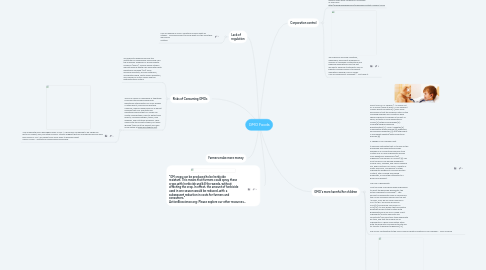GMO Foods
by Kimberly Coombs

1. "GM crops can be produced to be herbicide resistant. This means that farmers could spray these crops with herbicide and kill the weeds, without affecting the crop. In effect, the amount of herbicide used in one season would be reduced, with a subsequent reduction in costs for farmers and consumers." ActionBioscience.org: Please explore our other resources...
2. Lack of regulation
2.1. Lack of labeling in GMO's violates our basic rights as citizens. Consumers want to know what is in the food they are buying. Untitled
3. Risks of Consuming GMOs
3.1. According to research done by the Instititute for Responsible Technology and the American Academy of Environmental Medicine (AAEM), “several animal studies indicate serious health risks associated with genetically modified (GM) food,” including infertility, immune problems, accelerated aging, faulty insulin regulation, and changes in major organs and the gastrointestinal system.
3.2. The FDA claims no difference in traditional foods and those which have been genetically altered with DNA from dozens of other plants, animals and bacteria. However, memos made public by a lawsuit revealed that FDA scientists had repeatedly warned that GM foods can create unpredictable, hard-to-detect side effects, including allergies, toxins, new diseases, and nutritional problems. They urged long-term safety studies, but were ignored (check out the lawsuit and learn more details at www.biointegrity.org).
3.2.1. "Milk made with rBGH has higher levels of IGF-1, a hormone considered to be a high risk factor for breast, lung, and other cancers. Studies suggest that pre-menopausal women who have levels of IGF-1 are seven times more likely to develop breast cancer."Home - Institute for Responsible Technology
4. Farmers make more money
5. Corporation control
5.1. "As a precondition to buy seeds, either to plant for crops or to use in research study, Monsanto and the gene giant companies must first sign an End User Agreement with the company." During the main growth of GMO's in the past ten years, Monsanto and the other large seed firms, DuPont and Syngenta, have required anyone buying their seeds to sign an agreement stating they are prohibited from doing any independent research. Therefore scientists "are prohibited from testing a seed to explore under what conditions it flourishes or even fails." http://www.globalresearch.ca/index.php?context=va&aid=14570
5.2. The chemical and food industries, meanwhile, have spent hundreds on millions in campaign contributions and lobbying expenditures over the last decade to advance its interests. One of industry’s primary goals is to prevent mandatory labeling of GMO foods. Lack of Government Oversight | Just Label It
6. GMO's more harmful for children
6.1. About 43% of US children (~14 million out of 32 million) have at least 1 of 20 different chronic health conditions.[1] Even more worrisome is that the incidence rates of the following diseases and conditions have shown significant increases in the last 20 years, but with no clear explanations: cancer,[2] asthma and allergies[3] – including allergies requiring hospitalization[4] – Type 1 diabetes,[5] inflammatory bowel disease,[6] behavioral and learning disabilities,[7] and (although it is somewhat debated) autism spectrum disorder.[8] A change in our children’s diet It has been estimated that 70 to 80% of the processed and manufactured foods available in a conventional grocery store contain one or more ingredients derived from genetically engineered (GE) organisms (also known as “GMOs”).[9] The most common GE-derived ingredients include corn, soybean, and canola cooking oils, high-fructose corn syrup, a variety of meals and flours, and dozens of other ingredients designed to increase protein content, alter cooking and baking properties, or add other attributes to a given food product. The role of glyphosate Most GE food crops have been engineered to resist the herbicide glyphosate, the active ingredient in Roundup®. The amount of glyphosate used on farmland in the US has increased rapidly over the last 15 years, from 85-90 million pounds in 2001 to 180-185 million pounds in 2007[12] and around 250 million in 2015[13]. It is also known that formulated herbicide products that contain both glyphosate and a mix of so-called “inert” ingredients (mostly adjuvants and surfactants) are more toxic than glyphosate by itself, and that the unique mix of ingredients in a given formulation alters both the product’s environmental fate and its toxicity to different organisms.[14] Are GMOs contributing to the rise in chronic health conditions in our children? - GMO Science
6.2. "GMO foods cause a higher risk for Children," Michael Meacher, the former minister of the environment for the UK, said. "Any baby food containing GM products could lead to a dramatic rise in allergies. " GM corn is particularly problematic for children, as they generally eat a higher percentage of corn in their diet. Home - Institute for Responsible Technology


